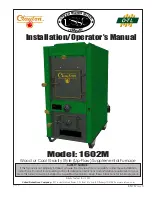
CNPHP: Installation Instructions
Manufacturer reserves the right to change, at any time, specifications and designs without notice and without obligations.
2
INSTALLATION
A06031
Fig. 1 – Furnace Coil
CNPHP furnace coils are NOT designed to be installed with furnaces
that measure wider than the coil itself.
Before installation, there are several other performance requirements
that must be considered because poor installation can negatively alter
performance. The following section will briefly discuss those factors.
Airflow
Airflow amount and distribution are vital to adequate system
performance. Problems that can be experienced with incorrect airflow
include:
• low system performance
• restricted TXV
• frosted coil
• poor humidity control
• water blow-off
NOTE:
In addition, heat pump applications require airflow in a
particular direction for best performance. See decal on front of coil for
correct direction.
When attaching the coil and building the plenum, pay special attention to
the effect these details will have on airflow. After system start-up, check
the cfm to insure that it is correct. (Generally, the cfm should be 350 to
400 cfm/ton during normal cooling operation.)
TXV
A thermal expansion valve is utilized in this coil design to optimize
performance and comfort throughout the entire operating range of the
system. Special attention needs to be taken to the TXV when installing
the coil
• Do not overheat valve. Temperatures that exceed 212°F (100°C) can
harm valve performance. Use a wet cloth or heat sink when brazing.
• Place liquid filter dryer near ID unit to reduce the risk of debris
clogging the valve.
• Make sure TXV bulb is securely fastened and wrapped in the
indentation on vapor line tube.
CNPHP Models:
These coils have a factory-installed hard-shutoff TXV designed only for
use with R-410A refrigerant. Use only with outdoor units designed for
R-410A.
NOTE:
All TXV’S have preset superheat settings and are not
field-adjustable.
Cabinet Sweating
If the unit is installed in a garage, attic, or other unconditioned space,
special attention may need to be given to the potential of cabinet
sweating.
Condensate Management
With proper installation, these coils will manage the condensate without
blow-off into the duct work. The 43, 60, and 61 size coils require the
addition of a pan extension for both horizontal left and horizontal right
position, which is supplied with the coils. See detailed instructions for
more info. Also, refer to Connect Condensate Drain Line section of this
instruction.
HORIZONTAL-RIGHT AND HORIZONTAL-LEFT
WITH PAN EXTENSION (43, 60, and 61 Sizes Only)
There are two separate pan extensions shipped with the unit. For
horizontal left installations, use the pan attached to the left shipping
bracket. For horizontal right installations, use the pan attached to the
right shipping bracket. Be sure to use the correct pan extension for the
application. There should not be any gaps between the plastic
condensate pan and the pan extension. All condensate should flow from
the pan extension to the plastic condensate pan and not leak into the coil
cabinet or duct.
NOTE:
Discard the pan not used and both shipping brackets.
For horizontal-left installation, install pan extension onto left end of
horizontal-condensate pan. Pan extension is slotted to fit onto
condensate pan edge and will extend into supply plenum (
).
A06032
Fig. 2 – Horizontal-Left Installation of Pan Extension
(43, 60 & 61 sizes only)
Shipping Brace
Remove
2 Screws
Pan Extension
CAUTION
!
PROPERTY DAMAGE HAZARD
Failure to follow this caution may result in property damage.
When installing over a finished ceiling and/or living area, install a
field-fabricated secondary condensate pan under the entire unit.
Supply
Plenum
Condensate Pan
Pan Extension
























